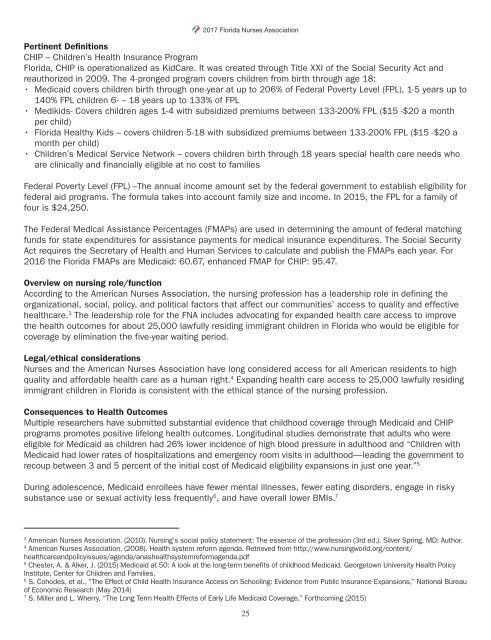2017 FNA Book of Reports
Create successful ePaper yourself
Turn your PDF publications into a flip-book with our unique Google optimized e-Paper software.
<strong>2017</strong> Florida Nurses Association<br />
Pertinent Definitions<br />
CHIP – Children’s Health Insurance Program<br />
Florida, CHIP is operationalized as KidCare. It was created through Title XXI <strong>of</strong> the Social Security Act and<br />
reauthorized in 2009. The 4-pronged program covers children from birth through age 18:<br />
• Medicaid covers children birth through one-year at up to 206% <strong>of</strong> Federal Poverty Level (FPL), 1-5 years up to<br />
140% FPL children 6- – 18 years up to 133% <strong>of</strong> FPL<br />
• Medikids- Covers children ages 1-4 with subsidized premiums between 133-200% FPL ($15 -$20 a month<br />
per child)<br />
• Florida Healthy Kids – covers children 5-18 with subsidized premiums between 133-200% FPL ($15 -$20 a<br />
month per child)<br />
• Children’s Medical Service Network – covers children birth through 18 years special health care needs who<br />
are clinically and financially eligible at no cost to families<br />
Federal Poverty Level (FPL) –The annual income amount set by the federal government to establish eligibility for<br />
federal aid programs. The formula takes into account family size and income. In 2015, the FPL for a family <strong>of</strong><br />
four is $24,250.<br />
The Federal Medical Assistance Percentages (FMAPs) are used in determining the amount <strong>of</strong> federal matching<br />
funds for state expenditures for assistance payments for medical insurance expenditures. The Social Security<br />
Act requires the Secretary <strong>of</strong> Health and Human Services to calculate and publish the FMAPs each year. For<br />
2016 the Florida FMAPs are Medicaid: 60.67, enhanced FMAP for CHIP: 95.47.<br />
Overview on nursing role/function<br />
According to the American Nurses Association, the nursing pr<strong>of</strong>ession has a leadership role in defining the<br />
organizational, social, policy, and political factors that affect our communities’ access to quality and effective<br />
healthcare. 3 The leadership role for the <strong>FNA</strong> includes advocating for expanded health care access to improve<br />
the health outcomes for about 25,000 lawfully residing immigrant children in Florida who would be eligible for<br />
coverage by elimination the five-year waiting period.<br />
Legal/ethical considerations<br />
Nurses and the American Nurses Association have long considered access for all American residents to high<br />
quality and affordable health care as a human right. 4 Expanding health care access to 25,000 lawfully residing<br />
immigrant children in Florida is consistent with the ethical stance <strong>of</strong> the nursing pr<strong>of</strong>ession.<br />
Consequences to Health Outcomes<br />
Multiple researchers have submitted substantial evidence that childhood coverage through Medicaid and CHIP<br />
programs promotes positive lifelong health outcomes. Longitudinal studies demonstrate that adults who were<br />
eligible for Medicaid as children had 26% lower incidence <strong>of</strong> high blood pressure in adulthood and “Children with<br />
Medicaid had lower rates <strong>of</strong> hospitalizations and emergency room visits in adulthood—leading the government to<br />
recoup between 3 and 5 percent <strong>of</strong> the initial cost <strong>of</strong> Medicaid eligibility expansions in just one year.” 5<br />
During adolescence, Medicaid enrollees have fewer mental illnesses, fewer eating disorders, engage in risky<br />
substance use or sexual activity less frequently 6 , and have overall lower BMIs. 7<br />
3<br />
American Nurses Association. (2010). Nursing’s social policy statement: The essence <strong>of</strong> the pr<strong>of</strong>ession (3rd ed.). Silver Spring, MD: Author.<br />
4<br />
American Nurses Association. (2008). Health system reform agenda. Retrieved from http://www.nursingworld.org/content/<br />
healthcareandpolicyissues/agenda/anashealthsystemreformagenda.pdf<br />
5<br />
Chester, A. & Alker, J. (2015) Medicaid at 50: A look at the long-term benefits <strong>of</strong> childhood Medicaid. Georgetown University Health Policy<br />
Institute, Center for Children and Families.<br />
6<br />
S. Cohodes, et al., “The Effect <strong>of</strong> Child Health Insurance Access on Schooling: Evidence from Public Insurance Expansions,” National Bureau<br />
<strong>of</strong> Economic Research (May 2014)<br />
7<br />
S. Miller and L. Wherry, “The Long Term Health Effects <strong>of</strong> Early Life Medicaid Coverage,” Forthcoming (2015)<br />
25

















